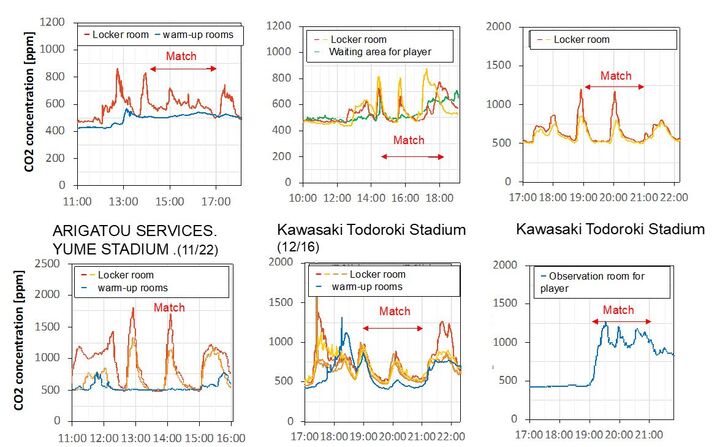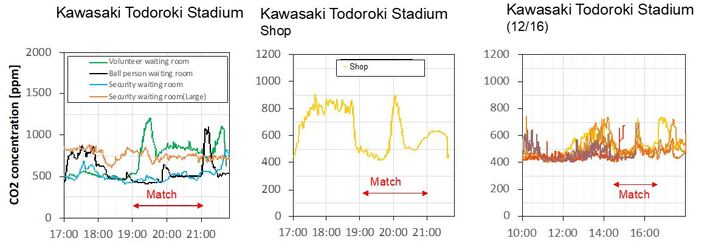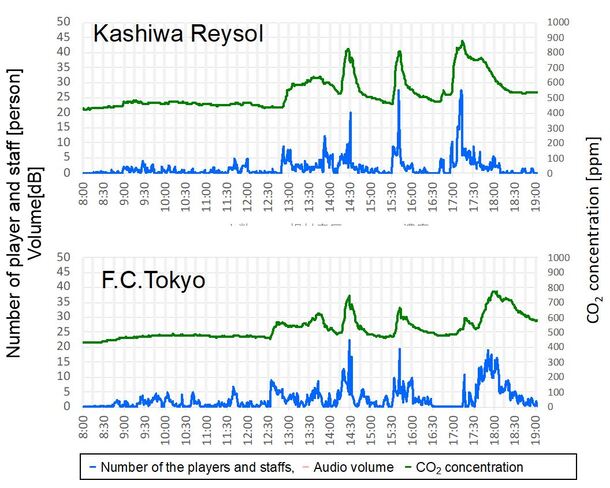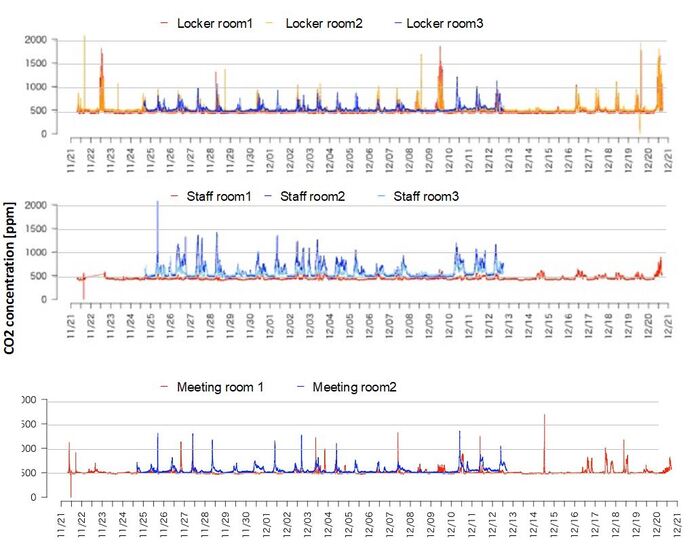Update(MM/DD/YYYY):06/18/2021
Investigation into preventing COVID-19 infections at J.League stadiums and clubhouses (second report)
-Investigation details and measurement of CO2 concentrations, congestion, and acoustic pressure in locker rooms and areas used by stadium personnel-
Researchers) YASUTAKA Tetsuo, NAITO Wataru, SHINOHARA Naohide, ONISHI Masaki, BANDO Yoshiaki
Key points
- Measured CO2 concentrations in locker rooms and stadium personnel areas at 5 stadiums and 2 clubhouses to evaluate crowded and closed-space settings
- Visualized the relationship between player activity (from acoustic pressure and occupancy) and CO2 concentrations
- Evaluated congestion and close-contact levels in locker rooms at the Japan National Stadium using data obtained from image and acoustic sensors
- Found the correlation between occupancy level and acoustic volume in locker rooms and the corresponding CO2 concentration
Overview
The National Institute of Advanced Industrial Science and Technology (AIST) of Japan, the Japan Professional Football League (J.League), and 6 J.League clubs have partnered together to investigate the prevention of COVID-19 infections at stadiums and in team clubhouses in Japan. The investigation was conducted at 5 stadiums during J.League matches; during the final of the Levain Cup at the Japan National Stadium; and also at team club houses. It involved evaluating the risks of infection posed to spectators, players, and club personnel. The evaluation was conducted by measuring CO2 concentrations as an indicator of the ventilation or closed /crowded settings and also by using lidar, image sensors, acoustic sensors, and other devices to evaluate congestion levels; the degree of close contact; and spectator behavior. These evaluations were in turn used to quantify the degree to which the so-called “Three Cs” were manifested at these sites. (The Three Cs in Japan are easy-to-understand situations or combinations thereof that should be avoided to reduce the risk of infection. The situations to avoid are as follows: poorly ventilated Closed spaces; Crowded spaces; and settings where there is Close-contact between people.)
The partnership is more specifically between AIST (president: ISHIMURA Kazuhiko); AIST Resource Geochemistry Research Group (research group director: YASUTAKA Tetsuo); AIST Institute for Geo-Resources and Environment Research (research division director: MITSUHATA Yuji); AIST Risk Evaluation Strategy Group (research group director: NAITO Wataru and lead researcher: SHINOHARA Naohide); AIST Research Institute of Science for Safety and Sustainability (research division director: OGATA Yuji); AIST Social Intelligence Research Team (research team director: ONISHI Masaki and researcher: BANDO Yoshiaki), AIST Artificial Intelligence and Research Center (director: TSUJII Junichi); the Japan Professional Football League (chairperson: MURAI Mitsuru); and the football clubs FC Imabari, Montedio Yamagata, Hokkaido Consadole Sapporo, Kawasaki Frontale, FC Tokyo, and Kashiwa Reysol.
In the first report of this investigation, we reported the results of CO2 measurements and congestion levels (obtained using lidar) within stadiums to evaluate the risk of COVID-19 infection among spectators. (First report) In this second report, we report on the results of CO2 measurements in areas where players and staff enter the five stadiums and two clubhouses, and of close contact and congestion conditions using image and acoustic sensors in locker rooms at the Japan National Stadium, in order to assess the risk of novel coronavirus infection to "players and staff”. The findings are discussed herein.
We measured CO2 concentrations at locations such as locker rooms, warm-up rooms, referee changing rooms, and the management areas on the day of matches at 5 stadiums. Lockers rooms, where players spend a considerable amount of time while in stadiums, exhibited increased CO2 concentrations pre-match, at half-time periods, and post-match, while concentrations declined during the actual matches. The maximum concentrations ranged widely from stadium to stadium, being between 800 and 2,000 ppm. We believe this wide range is due to the differing sizes, occupancies, and ventilation levels of the locker rooms at each stadium.
At the Japan National Stadium, in addition to CO2 concentrations, we measured close contact and congestion among players by using image sensors and acoustic sensors. We found that the length of time in which 10 or more people were in the locker room was cumulatively between 12 and 33 minutes and, with the exception of meetings and post-match activities, players tended to be dispersed throughout the room. In addition, we visualized the relationship between player behavior (on the basis of acoustic pressure and occupancy) and CO2 concentrations in locker rooms from pre-match to post-match and found that there was a positive correlation. This suggests that use of more spacious rooms, restricting the number of occupants, or other measures may prove useful in reducing close contact and congestion in these spaces.
The CO2 readings taken in clubhouses revealed that in locker rooms and meeting rooms, there were temporary increases in CO2 concentrations before and after training and during meetings, with some stadium management areas(staff room) having higher CO2 concentrations relative to locker rooms. These findings can be used to formulate infection prevention guidelines, to evaluate infection risk, and can be taken into consideration when determining the efficacy of countermeasures used to protect players and personnel during sporting events at stadiums and during everyday clubhouse usage.

Fig. 1: Summary of scope of second report
Please refer to the first report for the societal backdrop, origins of this research, and a broader discussion of scope. (First report), The Three Cs in Japan are easy-to-understand situations or combinations thereof that should be avoided to reduce the risk of infection. The situations to avoid are as follows: poorly ventilated Closed spaces; Crowded spaces; and settings where there is Close-contact between people.
Details of the investigation in the second report
We took measurements during 7 matches at 5 stadiums (Arigatou Service. Yume Stadium of FC Imabari, ND Soft Stadium of Montedio Yamagata, Sapporo Dome of Hokkaido Consadole Sapporo, and Kawasaki Todoroki Stadium of Kawasaki Frontale), and the Japan National Stadium (during the final of the Levain Cup). CO2 concentration was measured in the player and referee changing rooms and other areas using CO2 sensor as an indicator of the ventilation or closed /crowded settings. Image and acoustic sensors were used to determine levels of congestion and close contact and player and personnel behavior. In addition, we measured CO2 concentrations at approximately 20 locations in the FC Imabari and Montedio Yamagata clubhouses. Please note that only image and acoustic sensors were deployed at the Japan National Stadium.

Fig. 2: Installation of image sensors, acoustic sensors, and CO2 concentration instruments in locker rooms at the Japan National Stadium (Note that image and voice data were not acquired during the actual measurement phase)
CO2 concentrations in stadium locker rooms
CO2 concentrations at the 5 stadiums increased pre-match, post-match, and at half-time, while falling during actual matches. CO2 concentrations reached highs of between 800 and 2,000 ppm. Sapporo Dome and the Japan National Stadium had comparatively lower concentrations. Concentrations in referee changing rooms exhibited a similar trend, with maximum CO2 concentrations being approximately 800 to 2,000 ppm (Fig. 4, left). As with the locker rooms, CO2 concentrations in referee changing rooms were relatively lower at Sapporo Dome and the Japan National Stadium. In addition, we also conducted CO2 measurement in player spectating areas (i.e., areas used by players not taking part in a match) at the Kawasaki Todoroki Stadium, with 1,250 ppm being the highest recorded value.

Fig. 3: Changes in CO2 concentration in locker rooms, warm-up rooms, and player spectating areas (Line color indicates different data collection points)
In contrast to locker rooms, the CO2 concentrations in management areas occupied by operations personnel (Fig. 4, center) were between 400 and 800 ppm. Concentrations in rooms used by the media (Fig. 4, right) and waiting rooms for volunteers, ball carriers, and security guards (Fig. 5, left) at the Kawasaki Todoroki Stadium were between 400 and 800 ppm at the highest, but some rooms exceeded 1,000 ppm at certain times. The indoor merchandise shop (Fig. 5, center) at Kawasaki Todoroki Stadium reached a maximum of approximately 800 ppm. This shop is located indoors, but the number of persons permitted to enter is limited and two doors are kept open, leading to what we consider to be good ventilation conditions. The outdoor merchandise shop (Fig. 5, right) at the Japan National Stadium was between 400 and 800 ppm.

Fig. 4: Changes in CO2 concentrations in the referee changing rooms (left), management area(e.g., Staff room)(center), and media rooms at Kawasaki Todoroki Stadium(right)

Fig. 5: Changes in CO2 concentrations in various rooms at Kawasaki Todoroki Stadium (left) in an indoor merchandise shop at Kawasaki Todoroki Stadium (center), and in various outdoor merchandise shops and food kiosks at the Japan National Stadium (right)
Sensor measurements in locker rooms
Fig. 6 shows occupancy, audio volume, and CO2 concentrations in the Kashiwa Reysol and F.C. Tokyo locker rooms of the Japan National Stadium as measured using image sensors and acoustic sensors during the final of the Levain Cup. Audio volume and CO2 concentrations tended to increase when a player entered the locker room. Pre-warmup, pre-match, during half-time, and post-match, there tended to be a large number of people in these rooms, which led to more audio volume commensurate with the number of occupants. Maximum occupancy in locker rooms was respectively 27 and 22, which is on the high side, but the periods in which 10 or more players were in the locker rooms were 12 and 33 minutes, respectively. With the exception of post-match periods and during meetings, there were few players in these rooms. In addition to locker rooms, the J.League utilizes coach/supervisor rooms for players and personnel, which appeared to encourage the dispersal of players throughout the facilities. This was borne out by the visualized data on correlations between player activity (acoustic pressure and occupancy) and CO2 concentration. This suggests that use of more spacious rooms, restricting the number of occupants, or other measures can prove useful in reducing close contact and congestion in these spaces.

Fig. 6: Correlation between audio volume and occupancy at the Japan National Stadium and corresponding CO2 concentrations
Findings on CO2 concentrations within clubhouses
We measured CO2 concentrations at approximately 20 locations within the Montedio Yamagata and FC Imabari clubhouses between late November and mid-December (Fig. 7). We found that CO2 concentrations within the clubhouses temporarily increased in locker rooms, meeting rooms, training rooms, and other locations prior to and after training sessions and when meetings were held, with the length of time of each activity varying (in most cases, between 2 and 3 hours). Some of the stadium management areas were found to have relatively high, constant CO2 concentrations when compared with locker rooms. In face-to-face interviews, we learned that each team is taking a range of measures that include periodically opening windows, ventilating using industrial fans, using air purifiers, and making two separate lockers rooms available for players.

Fig. 7: CO2 concentrations within clubhouses
For this report, we measured the CO2 concentrations in locations such as locker rooms, warm-up rooms, referee changing rooms, management areas, and other areas designated for use by players and personnel at five stadiums. In addition, our findings include readings from image and acoustic sensors installed in locker rooms and referee changing rooms at the Japan National Stadium. We found that there were discrete times of the day during which CO2 concentrations at sites used by players and personnel were high, and the correlation between these times and volume levels and occupancy of locker rooms was confirmed by using image and acoustic sensors. We also found that the greater the occupancy of a locker room, the greater the audio volume and CO2 concentration increase, suggesting that use of more spacious rooms, restricting the number of occupants, or other measures can prove useful in reducing close contact and congestion in these spaces. Our findings also indicated the possibility that close contact occurring within clubhouses is transitory in nature.
From the standpoint of risk reduction, in rooms where a large increase in CO2 concentration was found to continuously persist for beyond a given length of time when multiple people had entered the room, measures might include using a larger room, wearing non-woven masks, increasing ventilation, utilizing ventilators to increase ventilation, and deploying air purifiers (many clubs have already deployed such equipment). The players, referees, supervisors, coaches, and some other personnel are subject to regular PCR screenings once every two weeks, but general personnel and members of the media may not be having regular PCR tests in some cases. Given that the possible risks change depending whether a person has had a PCR test, such conditions should be taken into account when considering possible measures. We expect that these findings, used in conjunction with the findings from the first report, will i)aid in the development of guidelines for large-scale events at stadiums and other venues; ii)help in evaluating the possible risks of COVID-19 infection; and iii) assist in evaluating the effectiveness of specific countermeasures.
Future plans
Going forward, we intend to continue evaluating the risk of COVID-19 infection among spectators, players, and personnel at stadiums and clubhouses by using the data obtained in this report and integrating it with environmental and other data to assess possible countermeasures.
Research history
Since October 2020, AIST has been working with the J.League and J.League clubs to conduct investigation in areas used by spectators, such as stadium seats, concourses, and restrooms. For information about the implementation status and results of field tests we have conducted so far, see below.
Note
This report is available in Japanese on January 25, 2021. Here is the English version of the same content.
Contact address
National Institute of Advanced Industrial Science and Technology (AIST)
Institute for Geo-Resources and Environment Research, Resource Geochemistry Research Group
Research group director: Tetsuo Yasutaka, E-mail: t.yasutaka*aist.go.jp (* change to @)
Research Institute of Science for Safety and Sustainability, Risk Evaluation Strategy Group
Research group director: Wataru Naito, E-mail: w-naito*aist.go.jp (* change to @)
Artificial Intelligence and Research Center, Social Intelligence Research Team
Rsearch team director: Masaki Onishi, E-mail: onishi-masaki*aist.go.jp (* change to @)